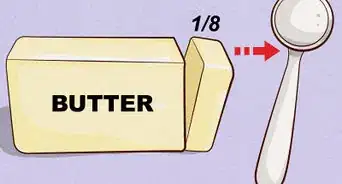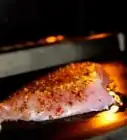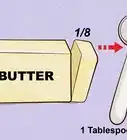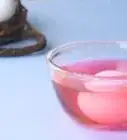This article was co-authored by Alex Hong. Alex Hong is the Executive Chef and Co-Owner of Sorrel, a New American restaurant in San Francisco. He has been working in restaurants for over ten years. Alex is a graduate of the Culinary Institute of America, and has worked in the kitchens of Jean-Georges and Quince, both Michelin-starred restaurants.
This article has been viewed 219,427 times.
Depending on the recipe, ounces can be a measurement of volume or weight. Fluid ounces are a measurement of volume, whereas dry ounces are a measurement of weight. As long as the ingredient is measured carefully, dry or liquid measuring cups should give you a simple and accurate calculation. For the most precise reading, use a kitchen scale to measure your ingredient.
Steps
Calculating Fluid Ounces
-
1Use a fluid measuring cup if you are handling a liquid. The measuring cup used will work best if it's for fluid ounces if measuring a liquid. Dry cups won't give as accurate of a reading because they are designed to measure weight instead of volume, but you can still try it if that's all you have![1]
- One dry measuring cup equals 8 fluid ounces.
-
2Place the measuring cup on a flat, stable surface. Choose a measuring cup that measures in ounces or can be easily converted to it. Lay the cup on as even of a surface as possible, like a table.
- Avoid holding the cup in your hand while measuring, as the reading will be slightly off.
Advertisement -
3Pour the liquid to approximately the desired line. Fill the measuring cup until it reaches slightly underneath the level you are hoping to reach. Squat down until you are about eye level with the line to check your measurement, as looking from above can give you a warped measurement.[2]
-
4Adjust the measurement until the bottom of the meniscus reaches the line. While measuring liquid ounces, you may notice that the top of the surface is not even and may curve along the edges. This curve is called the meniscus. For the most accurate reading, the bottom (not the top) of the meniscus should reach the desired line.[3]
Measuring Dry Ounces
-
1Use dry measuring cups for solid ingredients. Dry and liquid ounces are slightly different measurements. While dry ounces are a measurement of weight, liquid ounces are a measurement of volume. For solids, choose a dry measuring cup that uses ounces or something that can be easily converted to ounces.
-
2Put the ingredient being measured in a wide-mouthed container. You will be better able to put the measuring cup into the container if it has a large, open mouth. If the ingredient is not currently in an open-mouthed jar or bag, pour it into a bowl before you measure it.[4]
-
3Dip a measuring cup into the container. Use a measuring cup that marks ounces or that can be easily converted into ounces (like cups). As you lift the measuring cup out of the ingredient, let it overflow from the top. You can even the measurement out later on.[5]
-
4Use a knife to level off the measuring cup. Scrape the back of the knife over the top of the measuring cup to even out your measurement. Level the ingredient off over the bowl or container so it can catch anything that falls off the top of the measuring cup.[6]
- Any utensil with a straight, flat edge (like a spatula) can be used as an alternative to a knife.
Using a Kitchen Scale
-
1Weigh the cup on a kitchen scale to check your measurements. After you have leveled off the cup, it should be accurate. But if you want a more precise measurement, place the cup on a kitchen scale that can measure in ounces. Compare the scale's reading to your initial measurement to determine how accurate your measuring cup is.[7]
-
2Zero out the measuring cup's weight. Place the empty measuring cup on the scale before you fill it with the ingredient. This will allow you to get the exact measurement of the ingredient in ounces. If you have a digital scale, hit the "on" or "clear" button to zero out the weight.[8]
- If you have an older, mechanical scale, turn the knob back to the zero mark after placing the measuring cup on it.
- For balance scales, set the pointer to the center mark.
-
3Fill the measuring cup with the ingredient and place it on the scale. Lift the measuring cup off of the scale and add the ingredient you want to measure. Adjust the ingredient amount by adding or removing until it reaches the desired amount of ounces.
- Make sure the scale is set to ounces before measuring your ingredient.
-
4Weigh each ingredient separately if weighing multiple items. Use different measuring cups to keep the ingredients separate. Remember to zero out each cup before recording the ounce measurement for the most precise reading.
Community Q&A
Did you know you can get answers researched by wikiHow Staff?
Unlock staff-researched answers by supporting wikiHow
-
QuestionIs 1 oz the same as 1 fl oz?
 wikiHow Staff EditorThis answer was written by one of our trained team of researchers who validated it for accuracy and comprehensiveness.
wikiHow Staff EditorThis answer was written by one of our trained team of researchers who validated it for accuracy and comprehensiveness.
Staff Answer wikiHow Staff EditorStaff AnswerNot necessarily. An ounce can be either a measure of weight or a measure of volume (like a cup or a milliliter). A fluid ounce (fl oz) is a volume measurement, usually used for measuring liquids. However, sometimes people will simply say or write “ounce/oz” without the "fluid/fl" when they’re talking about fluid ounces. So, check the context to figure out which is more likely. For instance, 1 oz of milk is likely a fluid ounce, while 1 oz of garlic would probably be a weight measurement.
wikiHow Staff EditorStaff AnswerNot necessarily. An ounce can be either a measure of weight or a measure of volume (like a cup or a milliliter). A fluid ounce (fl oz) is a volume measurement, usually used for measuring liquids. However, sometimes people will simply say or write “ounce/oz” without the "fluid/fl" when they’re talking about fluid ounces. So, check the context to figure out which is more likely. For instance, 1 oz of milk is likely a fluid ounce, while 1 oz of garlic would probably be a weight measurement. -
QuestionHow many ounces are in a measuring cup?
 wikiHow Staff EditorThis answer was written by one of our trained team of researchers who validated it for accuracy and comprehensiveness.
wikiHow Staff EditorThis answer was written by one of our trained team of researchers who validated it for accuracy and comprehensiveness.
Staff Answer wikiHow Staff EditorStaff Answer
wikiHow Staff EditorStaff Answer -
QuestionHow many ounces is a cup of flour?
 wikiHow Staff EditorThis answer was written by one of our trained team of researchers who validated it for accuracy and comprehensiveness.
wikiHow Staff EditorThis answer was written by one of our trained team of researchers who validated it for accuracy and comprehensiveness.
Staff Answer wikiHow Staff EditorStaff Answer
wikiHow Staff EditorStaff Answer
Expert Interview
References
- ↑ https://www.thekitchn.com/whats-the-difference-between-ounces-and-fluid-ounces-224303
- ↑ https://www.cooksillustrated.com/how_tos/5450-dry-versus-liquid-measuring-cups
- ↑ http://www.seriouseats.com/2015/03/how-to-measure-wet-dry-ingredients-for-baking-accurately-best-method.html
- ↑ http://www.seriouseats.com/2015/03/how-to-measure-wet-dry-ingredients-for-baking-accurately-best-method.html
- ↑ https://kirbiecravings.com/2015/03/baking-101-liquid-vs-dry-measuring-cups.html
- ↑ https://www.cooksillustrated.com/how_tos/5450-dry-versus-liquid-measuring-cups
- ↑ https://www.gourmetsleuth.com/ingredients/detail/dry-measuring-cups
- ↑ https://smittenkitchen.com/2010/08/how-to-use-a-kitchen-scale/
About This Article
To measure ounces, select either a liquid or dry measuring cup. If you’re measuring a liquid, place the measuring cup on a flat surface and pour the liquid into the cup. Be sure to bend down to view the measurements on the side of the cup. Make sure the liquid reaches the right measurement. For a dry ingredient, use the measuring cup to scoop out the ingredient. If the cup is overflowing, scrape a knife across the top to level it.





















































